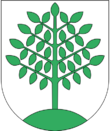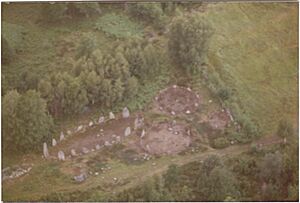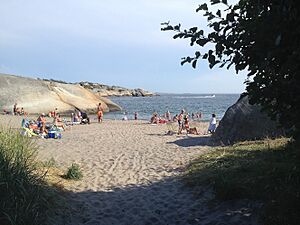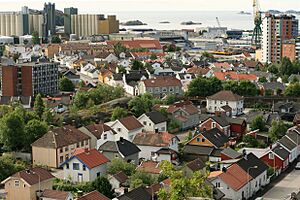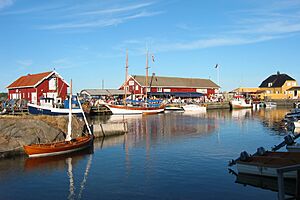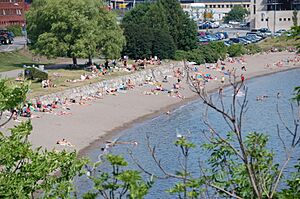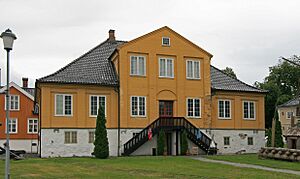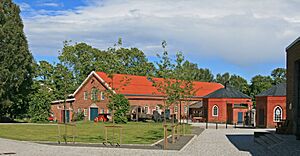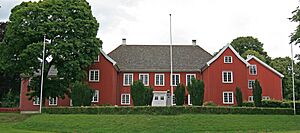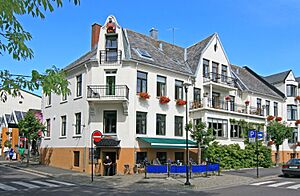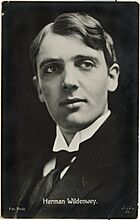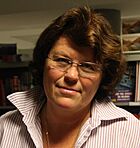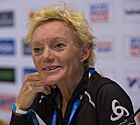Larvik facts for kids
Quick facts for kids
Larvik kommune
|
|||||
|---|---|---|---|---|---|
|
Municipality
|
|||||
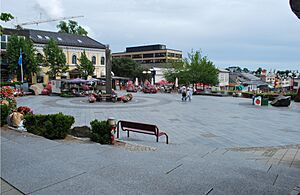
Larvik town square, 2008
|
|||||
|
|||||
| Nickname(s):
Bakkebyen, The Hilly City
|
|||||
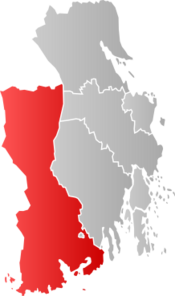
Larvik within Vestfold
|
|||||
| Country | Norway | ||||
| County | Vestfold | ||||
| Established | 1 Jan 1838 | ||||
| Administrative centre | Larvik | ||||
| Area | |||||
| • Total | 812.88 km2 (313.85 sq mi) | ||||
| • Land | 771.41 km2 (297.84 sq mi) | ||||
| • Water | 41.47 km2 (16.01 sq mi) 5.1% | ||||
| Area rank | #140 in Norway | ||||
| Population
(2023)
|
|||||
| • Total | 48,246 | ||||
| • Rank | #21 in Norway | ||||
| • Density | 62.5/km2 (162/sq mi) | ||||
| • Change (10 years) | 5.9% | ||||
| Demonyms | Larviking Larviker Larvikar |
||||
| Time zone | UTC+01:00 (CET) | ||||
| • Summer (DST) | UTC+02:00 (CEST) | ||||
| ISO 3166 code | NO-3909 | ||||
| Official language form | Neutral | ||||
| Created as | Formannskapsdistrikt in 1838 | ||||
|
|
|||||
Larvik is a municipality in Vestfold county, Norway. It is located in the traditional Vestfold area. The main town and administrative center is also called Larvik. Other important places in the municipality include the town of Stavern and villages like Helgeroa and Svarstad.
Larvik is quite large, covering about 813 square kilometers. It is the 140th largest municipality in Norway by area. With a population of over 48,000 people, it is the 21st most populated municipality in the country. The population has grown by almost 6% in the last ten years.
The city of Larvik became a market town in 1671. It became a self-governing municipality on January 1, 1838, when a new law about local government started.
Larvik is famous as the hometown of Thor Heyerdahl, a well-known explorer. It is also home to Bøkeskogen, which is the northernmost natural forest of beech trees in the world. Larvik also has Norway's only natural mineral water spring, called Farriskilden. The Farris Bad spa, located in Larvik, is known as one of the best spas in Europe and has the largest spa area in Scandinavia.
Contents
About Larvik
The town of Larvik became its own municipality on January 1, 1838. Over the years, some smaller areas from nearby municipalities like Brunlanes and Hedrum joined Larvik.
A big change happened on January 1, 1988. The city of Larvik merged with the municipalities of Brunlanes, Hedrum, and Tjølling, and the town of Stavern. This created a much larger Larvik Municipality with about 37,000 people.
Later, on January 1, 2018, Lardal Municipality also merged with Larvik. After this merger, Larvik became the largest municipality in Vestfold by area and the second most populated.
What does the name Larvik mean?
The name Larvik comes from an old Norse word, Lagarvík. This name describes a small bay at the end of the Larviksfjorden. The first part, Lagar, means 'water' or 'river', referring to the Numedalslågen River. The second part, vík, means 'cove' or 'inlet'. So, the name Larvik means 'cove at the mouth of a river'. Before 1889, the name was sometimes spelled Laurvik or Laurvig.
Larvik's Coat of Arms
Larvik has had three different coats of arms since 1889. A coat of arms is like a special symbol or emblem for a city or family.
The first coat of arms, used until 1989, showed a green tree growing from a green hill on a white background. The tree symbolized the local beech forest. This design was chosen because a beech tree had been used as a symbol by a local governor and a guild in the past.
The second coat of arms, used from 1989 to 2018, showed a ship's mast with three sails on a blue background. The blue color and the ship design represented Larvik's strong connection to the sea and its maritime history.
The current coat of arms, adopted in 2018, has a blue background with a silver tree. This tree has seven leaves shaped like water droplets. The seven drops symbolize water flowing from forests into streams and rivers like the Numedalslågen and Farris. The tree also represents the important local beech forests and the forestry industry. The six water drops also stand for the ports along the coast and the six former municipalities that now form the larger Larvik.
Larvik's History
Many ancient remains from the Stone Age have been found in Larvik. For example, at Mølen, ancient people built many burial mounds using rocks from the Raet ridge. At Istrehågan, during the Roman Iron Age, people created a stone monument that looks like a ship. This is one of Norway's most important ancient sites.
About 4 kilometers southeast of the town is Skiringssal. Here, archaeologists found burial mounds and an old Viking hall. They also discovered the remains of an ancient town called Kaupang. This is known as the oldest merchant town in Norway, where international trade happened over 1,200 years ago. Kaupang is one of the earliest urban sites found in the Nordic countries.
Larvik was an old coastal village. In 1671, it became a market town. This happened when Ulrik Frederik Gyldenløve bought the Fritsø estate and became the first Count of Laurvig. He built a new home called "Herregården" in 1674, which you can still visit today. The Larvik area was owned by a Danish Count until 1817.
Larvik, along with nearby cities like Sandefjord and Tønsberg, was a major whaling city in Norway in the late 1800s and early 1900s.
People of Larvik
| Ancestry | Number |
|---|---|
| 1439 | |
| 587 | |
| 535 | |
| 439 | |
| 305 | |
| 275 | |
| 245 | |
| 229 | |
| 227 | |
| 207 | |
| 203 | |
| 198 | |
| 176 | |
| 173 | |
| 161 | |
| 148 | |
| 132 | |
| 127 | |
| 123 | |
| 106 |
Most of Larvik's population lives along the coast. The main town, Larvik, is one of two cities in the municipality; the other is Stavern. Many homes are built on the hills between the fjord and Bøkeskogen.
As of 2023, Larvik had a total population of 48,396 people. About half of these people live in the city of Larvik. The population often doubles during summer because of tourism. Larvik has almost 5,000 vacation homes.
Larvik's Economy
Larvik is very important for farming in Vestfold county. Farmers grow grains, potatoes, and vegetables. Larvik produces the most cucumbers and tomatoes in the county. Other important jobs are in shops, hotels, and restaurants.
The fishing industry in Larvik is the second largest in Vestfold. Important fishing harbors are Stavern, Helgeroa, and Nevlunghavn. Larvik also has the biggest logging industry in the county, with Norway Spruce being the most important tree. A special mineral called Larvikite is mined here and sent to countries in Europe and the United States.
Tourism in Larvik
Larvik is a popular place for summer vacations. It has a mild climate and many sunny days, which attracts many tourists. It has nearly 5,000 holiday homes.
The coastal town of Stavern and the pretty villages of Helgeroa and Nevlunghavn get many tourists in the summer. Stavern's population more than doubles during these months. Fun places to visit in Stavern include the Hall of Remembrance, Fredriksvern, and Citadel Island. Citadel Island has Staverns Fortress from the 1680s and is a place where artists work today.
Kaupang is a major attraction in Larvik. It is known as Norway's most important site from the Viking Age. Mølen Geopark is also a very popular tourist spot. Other places to see include the Maritime Museum, Fritzøehus, Herregården, the home of Thor Heyerdahl, and Bøkeskogen. Larvik is also home to Farris Bad, the largest spa in the Nordic countries, which is considered one of Europe's best.
Larvik's Geography

Larvik is in the southwestern part of Vestfold county. It is located between Sandefjord Municipality to the east and the Langesundsfjorden to the west. Larvik's coastline has many beaches, bays, and small islands. The land is mostly flat near the coast, but the inner parts have large, hilly forests. Taller mountains are found near the border with Telemark County in the west. The municipality has a 110-kilometer long coastline.
Larvik is about 105 kilometers southwest of Oslo, the capital of Norway. It covers an area of 813 square kilometers, making it the largest municipality in Vestfold county. Larvik has its own fjord that connects to the Lågen River.
Larvik borders Kongsberg Municipality to the north, Sandefjord Municipality to the east, and Porsgrunn Municipality and Siljan Municipality to the west. The highest point in Larvik is the 622-meter tall mountain Vindfjell.
Important natural features include Farris Lake and the Numedalslågen River, also called Lågen. The river ends at the Larviksfjorden in the town of Larvik. Other lakes include Goksjø and Hallevatnet.
Larvik is also known for its natural mineral water springs, called Farriskildene. This water is bottled and sold as Farris. At Kaupang in Tjølling, you can find the remains of the old medieval trading post of Skiringssal. Larvik is also home to Bøkeskogen ("The Beech Tree Forest"), the world's northernmost natural forest of Fagus sylvatica (European Beech trees).
Villages and Towns
The municipality has two cities and several larger villages:
- Larvik (city), with a population of about 26,851.
- Stavern (city), with a population of about 5,902.
- Other villages include Tveteneåsen, Hem, Helgeroa and Nevlunghavn, Kvelde, Verningen, and Svarstad.
There is a small area called Himberg that belongs to Sandefjord Municipality but is completely surrounded by Larvik. People from Himberg have protested against joining Larvik.
Getting Around Larvik
Larvik is served by Sandefjord Airport Torp, which is its closest international airport. The European route E18 highway, a very important road in Norway, goes through the municipality. Larvik Station is the main train station, located on the Vestfoldbanen railway line.
Daily ferries to Hirtshals, Denmark, leave from Larvik's harbor. These ferries are run by Color Line.
Fun Activities and Nature
Larvik offers many outdoor activities. You can visit Lydhusstranda beach at Naverfjorden.
The Numedalslågen River is known as one of Norway's best rivers for salmon fishing. You can also fish in Goksjø Lake, which is on the border between Sandefjord and Larvik. This lake has many types of fish, like pike and perch. Goksjø is also used for ice-skating, canoeing, swimming, and boating.
The 12-meter tall Trollfoss is the largest waterfall in Vestfold County.
There are many hiking trails in Larvik. You can find them in the city forest Bøkeskogen, which is Norway's largest beech tree forest. Trails here range from 2.6 km to 10 km long. Hiking trails are also at Mølen, which is a UNESCO Global Geopark and has Norway's largest stone beach. The Coastal Path (Kyststien) is a 35 km path that goes through Brunlanes to the town of Stavern. You can also find hiking trails by the lakes Goksjø and Farris. Farris Lake is the largest lake in Vestfold County.
Because Larvik has many rural areas, it's a great place for hunting. There are many moose, and Larvik has one of the highest numbers of moose in Norway. Other animals that are hunted include Roe deer, Red deer, and European beaver.
Beaches in Larvik
Here are some of the public beaches in Larvik:
- Farris
- Rekkeviksbukta
- Batteritomta
- Gonstranda (Østre Halsen)
- Hvittensand (Østre Halsen)
- Corntin (Stavern)
- Blokkebukta (Naverfjord)
- Anvikstranda (Naverfjord)
- Stolpstadstranda (Naverfjord)
- Lydhusstranda (Naverfjord)
- Roppestad (Farris)
- Skjærsjø (Kvelde)
- Ula (Tjølling)
- Kjerringvik (Tjølling)
Larvik's Culture
Larvik Museum
The Larvik Museum Society started in 1916. The museum works to protect and restore the city's historic buildings.
The Treschow-Fritzøe Museum (Verkensgården) has exhibits about the old Treschow-Fritzøe ironworks. It shows tools, equipment, and models from the time when iron was produced in Larvik, from 1670 to 1870. The museum also explains how the stone larvikite is formed and used.
The Manor House (Herregården) was built in 1677 by Ulrik Fredrik Gyldenløve. It is a large wooden building with well-preserved interiors from the 1730s. Herregården is considered one of Norway's finest old Baroque wooden buildings from the 17th century.
The Larvik Maritime Museum (Larvik Sjøfartsmuseum) is in Larvik's oldest brick building, which dates back to 1730. This museum shows models of ships, paintings of sailing vessels, and other items related to the port's history at sea. One part of the museum is dedicated to the expeditions of Thor Heyerdahl, who was born in Larvik.
Fritzøehus Estate
Fritzøehus is a large private estate in Larvik. It has been owned by members of the Treschow family for a long time. It is Norway's largest privately owned estate.
Churches in Larvik
The Church of Norway has twelve parishes in Larvik municipality.
| Parish | Church name | Location | Year built |
|---|---|---|---|
| Berg | Berg Arbeidskirke | Helgeroa | 2007 |
| Berg Church | Berg | 1878 | |
| Old Berg Church | Berg | c. 1100 | |
| Hedrum | Hedrum Church | Hedrum | c. 1100 |
| Hvarnes | Hvarnes Church | Hvarnes | 1705 |
| Kjose | Kjose Church | Kjose | 1850 |
| Kvelde | Kvelde Church | Kvelde | 1871 |
| Lardal | Hem Church | Hem | c. 1100 |
| Styrvoll Church | Styrvoll | c. 1150 | |
| Svarstad Church | Svarstad | 1657 | |
| Larvik | Larvik Church | Larvik | 1677 |
| Langestrand Church | Larvik | 1818 | |
| Nanset | Nanset Church | Larvik | 1974 |
| Stavern | Fredriksvern Church | Stavern | 1756 |
| Tanum | Tanum Church | Tanum | c. 1100 |
| Tjølling | Tjølling Church | Tjøllingvollen | c. 1100 |
| Østre Halsen | Østre Halsen Church | Halsen in Larvik | 1983 |
Places to Visit

Here are some interesting places to visit in Larvik:
- Istrehågan: An ancient burial ground near the Larvik-Sandefjord border.
- Bøkeskogen: Norway's largest and the world's northernmost beech tree forest.
- Larvik Maritime Museum: Learn about Larvik's history with the sea. It has models by Colin Archer and an exhibit about Thor Heyerdahl.
- Helgeroa and Nevlunghavn: Two charming coastal villages next to each other.
- Kaupang in Skiringssal: See the remains of the oldest town ever found in the Nordic countries.
- Mølen: The first UNESCO Global Geopark in the Nordic countries. It has 230 stone mounds from the Iron Age.
- Farris Lake: The largest lake in Vestfold County.
- Stavern: A coastal town that used to be Norway's main naval base.
- Hall of Remembrance: The largest monument in Vestfold County.
- Citadel Island: A fort that became important during the Nordic War (1709–1720).
- Farris Bad: A spa built next to Larvik's best sandy beach. It is considered one of Europe's best spas.
- The Nesjar Monument: Located in Helgeroa, this monument was unveiled in 2016 to mark 1,000 years since the Battle of Nesjar.
- Herregården: Built in 1677, this is one of Norway's finest old Baroque buildings.
- Larvik Church: Built in 1877, it is known for its paintings.
- Childhood home of Thor Heyerdahl: You can find it at Steingata 7 in Larvik.
- Goksjø: The third-largest lake in Vestfold County, located on the Sandefjord-Larvik border. It's used for swimming, fishing, kayaking, and ice-skating.
Images for kids
Famous People from Larvik
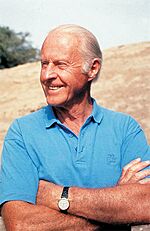
Honorary Citizens
- Thor Heyerdahl (1914–2002): An adventurer and explorer.
- Carl Nesjar (1920–2015): A painter and sculptor who worked with Pablo Picasso.
- Antonio Bibalo (1922–2008): An Italian-Norwegian pianist and opera composer.
- Arne Nordheim (1931–2010): A famous composer.
- Ingvar Ambjørnsen (born 1956): A well-known writer.
Explorers
- Johan Bryde (1858–1925): A ship-owner and whaler.
- Carl Anton Larsen (1860–1924): An Antarctic explorer.
- Oscar Wisting (1871–1936): A Norwegian Naval officer and polar explorer.
- Erik Hesselberg (1914-1972): A Kon-Tiki crew member, author, painter, and sculptor.
- Jarle Andhøy (born 1977): An adventurer and sailing skipper.
Public Service & Thinkers
- Jens Schou Fabricius (1758–1841): A Vice-admiral and Norwegian Minister of the Navy.
- Johan Sverdrup (1816–1892): A politician who was Prime Minister of Norway.
- Colin Archer (1832–1921): A Norwegian naval architect and shipbuilder.
- Sophus Bugge (1833–1907): A language expert.
- Bertrand Narvesen (1860–1939): A businessman who founded Narvesen stores.
- Niels Christian Ditleff (1881–1956): A diplomat known for the White Buses operation.
- Lars Gule (born 1955): A philosopher and expert on extremism.
- Anders Anundsen (born 1975): A politician who was Minister of Justice.
Artists
- Cecil Aagaard (1916–1984): A jazz singer and band leader.
- Mari Bjørgan (1950–2014): An actress and comedian.
- Birgitte Einarsen (born in 1975): A singer and musical theatre artist from Helgeroa.
- Terje Gewelt (born 1960): A jazz musician.
- Anne Holt (born 1958): A crime writer, lawyer, and former minister of justice.
- Louis Jacoby (born 1942): A singer and writer.
- Bjørn Lynne (born 1966): A sound engineer and music composer.
- Arne Nordheim (1931–2010): A composer.
- Arthur Omre (1887–1967): A novelist.
- Herman Wildenvey (1885–1959): A famous poet.
Sports Stars
- Sverre Hansen (1913–1974): A footballer who won a bronze medal at the 1936 Summer Olympics.
- Gunnar Thoresen (1920-2017): A famous footballer for Larvik Turn and the Norwegian national team.
- Anette Bøe (born 1957): A cross-country skier who won a bronze medal at the 1980 Winter Olympics.
- Hallvar Thoresen (born 1957): A footballer.
- Tom Erik Oxholm (born 1959): A speed skater who won two bronze medals at the 1980 Winter Olympics.
- Bjørg Eva Jensen (born 1960): A speed skater who won a gold medal at the 1980 Winter Olympics.
- Gunnar Halle (born 1965): A football manager and player.
- Espen Hoff (born 1981): A retired professional footballer.
- Alexander Hvaal (born 1992): A professional rallycross driver.
Sports Teams
- Larvik HK (handball)
- Larvik TIF
- IF Fram Larvik
Sister Cities
Larvik has friendly connections with these cities:
 Borlänge, Sweden
Borlänge, Sweden Frederikshavn, Denmark
Frederikshavn, Denmark
See also
 In Spanish: Larvik para niños
In Spanish: Larvik para niños




